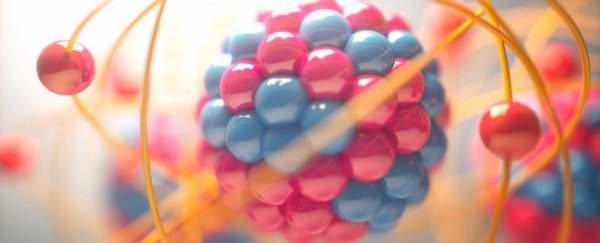Scientists have discovered the existence of a type of particle that's never previously been observed, which demonstrates unprecedented chemical stability for its kind.
It's big news for chemists and physicists – but the achievement isn't just exciting for theoretical scientists, because, if researchers can figure out how to make it in the lab, it could also enable new kinds of consumer products, such as aluminium-ion batteries.
The new discovery is the modelling of what's called a tri-anion particle, so-called because they contain three more electrons than protons.
While these have been found before, they've always been atomically unstable in the gas phase due to their surplus of electrons – that is, until now.
Researchers at Virginia Commonwealth University used computer modelling to show that stable tri-anions are in fact possible – at least hypothetically – as long as you've got the right molecular ratios of the elements boron and beryllium paired with the chemical compound cyanogen.
Tri-anion particles are usually unstable in the gas phase because their extra electrons means they dispel additional electrons due to strong electrostatic repulsion, which interrupts chemical reactions.
But a team led by physicist Puru Jena used quantum mechanical calculations to show that a molecule called BeB11(CN)12 is actually chemically stable – so robust in fact, that they described it in their paper as exhibiting "colossal stability".
"This is very important in this field, nobody has ever found such a tri-anion," says Jena.
"Not only can it keep three electrons but the third electron is extremely stable."
The researchers also had success substituting cyanogen for the chemical compounds thiocyanate (SCN) and borate (BO) .
"The implication of the extraordinary stability of the above tri-anions is that one can regard this class of clusters as super-pnictogens," the researchers write, "analogous to super-halogens discovered more than 30 years ago."
Pnictogens are a class of chemicals including nitrogen and phosphorus that have three unpaired electrons in their outermost electron shell, and which are known for their stability.
These belong in group 15 of the Periodic Table, and the researchers say the newly discovered BeB11(CN)12 – and its thiocyanate and borate variants – mimic the chemistry and stability of the group.
What that means in terms of industrial applications is that they could be used to develop new kinds of aluminium-ion batteries, with the tri-anion helping to make the battery conductive by moving from one of its electrodes to the other.
Much like with di-anions – particles that have two additional electrons – tri-anions could be used for much more than just batteries, however.
"Such particles are very important for many reasons. Number one, they make salts. Secondly, they are used in all kinds of chemical compounds, such as those in floor cleaners as oxidising agents that kill bacteria," Jena says.
"They are also used to purify air, which is a billion-dollar industry, and in mood enhancers, similar to what Prozac does. The potential uses are endless."
To be clear, the results are only based on computer modelling for now, so someone still needs to physically create the particle in the lab.
But perhaps the most exciting part of the discovery is that now that we know these colossally stable kinds of particles are possible, it will encourage scientists to look for what other kinds of never-before-seen molecular arrangements are out there.
"The guiding principles we have used in this paper will help with the design of other tri-anions," Jena says.
"The question is: What do we do with this knowledge?"
It sounds like it won't be long before we find out.
The findings are reported in Angewandte Chemie.
